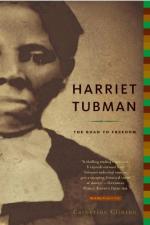|
This section contains 320 words (approx. 1 page at 400 words per page) |

|
Eastern Shore of Maryland
Harriet Tubman was born here and after escaping, she made many trips into the area to rescue family members.
The Underground Railroad (UGRR)
The Underground Railroad was an informal, clandestine series of networks that helped slaves to freedom in the North. UGRR "conductors" would help move the fugitive slaves from "depot" to "depot."
Philadelphia
Harriet arrived in Philadelphia after escaping from slavery. She lived her before beginning her raids to free other slaves. By 1847, the city had a black population of 20,000.
Fugitive Slave Law of 1850
This law provided financial incentives for northern slave catchers. Many fugitives migrated to Canada with the law's passing.
Wilmington, Delaware
Thomas Garrett was an important UGRR stationmaster in Wilmington. Tubman often brought fugitives through this place on their way to Canada.
St. Catharines, Ontario, Canada
Tubman first came to St. Catharines in 1851 and this town would become her home...
|
This section contains 320 words (approx. 1 page at 400 words per page) |

|




